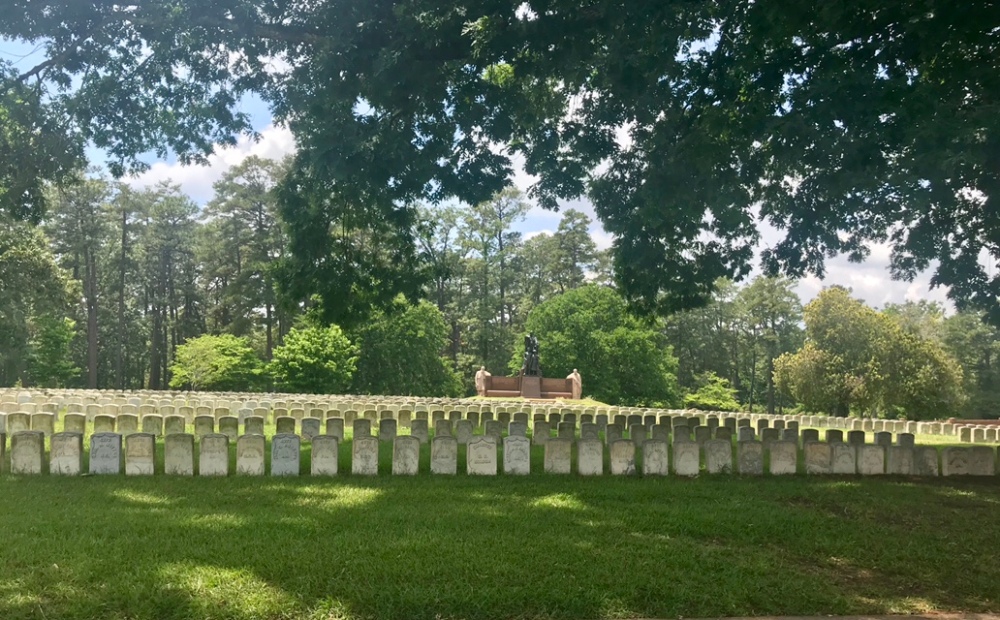In this segment we return to the story of Machias’s badass, Corporal Horace J. Andrus. My sister had the pleasure of meeting Corporal Andrus at the Machias Cemetery. He was laid to rest there in 1903.
I recently had an opportunity to visit Andersonville POW camp on a recent trip to Georgia and had the honor to learn more about our friend in Machias. At this point I would suggest you re-read Liz’s post Machias Cemetery Civil War to reacquaint yourself with our local war hero.
Corporal Andrus was a seasoned soldier, having participated in several major battles, by the time he was captured in 1864 just months before the end of the Civil War. He spent nine grueling months at Andersonville POW camp.
This camp was built in 1864 as a POW camp to hold 10,000 Union soldiers that were captured. It was a death camp for many as the camps population grew to 45,000. Only the walls and towers of the prison were completed. The barracks were never built, prisoners were forced to live in the open seeking shelter under blankets or any scraps of wood they could find. They drank from a spring that ran through the prison. This spring quickly became a cesspool due to over crowding. During the rainy season the grounds near the stream became a swamp and disease ran rampant. In a span of less than a year 13,000 men would die from malnutrition and disease at this camp.
The reason the prisoner population increased so quickly was due to a dispute over prisoner swaps towards in 1863. The Confederacy wanted to keep Black Soldiers as slaves and the Union would not agree to these terms. The prisoner swap program stopped for the remainder of the war.
Captain Henry Wirz ran the POW Camp. After the war he was tried and convicted for war crimes. His last words as he prepared to be executed were, “I know what orders are, Major. I am being hanged for obeying them.” It is interesting to note the President of the Confederacy, Jefferson Davis was granted amnesty and the mortality rate for both Union and Confederate Prisoners of war were very similar. Living conditions were atrocious on both sides.
How Corporal Andrus survived all this, we will never know. He must have been a very strong person. Having now visited the Andersonville POW camp I can say my sister’s assessment that he was a “badass” is accurate.
This National Historical Site is also home to a POW Museum. It offers historical accounts of the POW experience during numerous conflicts and wars. The exhibit contains videos interviews and letters home from POWs. The exhibit also features to scale replicas of different cages and cells U.S. soldiers have been held in. I don’t think I truly realized what POW meant until I visited this museum. POWs experienced something much darker and grizzlier than war.
One of my favorite parts of the POW Museum is the entry hall. You come through a dimly lit hall and a motion detector sets off a spotlight and the lights dim further. When you turn around to see where the spotlight is coming from, you notice several bayonets pointed at you from the wall behind you. It gives the illusion that you have been caught and taken prisoner. It’s a little theatrical, but goes a long way to put the patron in the right mind set to take in all the museum has to offer.
I also learned about women’s roles in the Civil War. I had never realized how many women had dressed as men and enlisted in the Civil War, it is believed to have been between 250-1,000 women. One of these women ended up a prisoner at Andersonville. This story led me to read She Went to the Field: Women Soldiers of the Civil War by Bonnie Tsui. It’s a great read about the many women who masqueraded as men. As you read you begin to realize that these may have been the beginnings of the Women’s Suffrage movement. Some of these women had been masquerading as men prior to the war and continued living as men long after the war ended. By masquerading as men these women could own property, pursue lucrative careers, and enjoy freedoms long withheld from women.
amzn_assoc_placement = "adunit0";
amzn_assoc_tracking_id = "pnwadventur0b-20";
amzn_assoc_ad_mode = "manual";
amzn_assoc_ad_type = "smart";
amzn_assoc_marketplace = "amazon";
amzn_assoc_region = "US";
amzn_assoc_linkid = "625cb7c6bf31ec6910ef1b4c47fcb198";
amzn_assoc_asins = "0762743840,B00HX0YOXY";
amzn_assoc_design = "in_content";
//z-na.amazon-adsystem.com/widgets/onejs?MarketPlace=US
After my visit at the museum I went to the cemetery. Many of these prisoners that were held at Andersonville are still buried here. The cemetery is now the resting place of over 20,000 people. It remains an active open cemetery for veterans, spouses, and dependent children.
amzn_assoc_placement = "adunit0";
amzn_assoc_search_bar = "true";
amzn_assoc_tracking_id = "pnwadventur0b-20";
amzn_assoc_search_bar_position = "bottom";
amzn_assoc_ad_mode = "search";
amzn_assoc_ad_type = "smart";
amzn_assoc_marketplace = "amazon";
amzn_assoc_region = "US";
amzn_assoc_title = "Shop Related Products";
amzn_assoc_default_search_phrase = "andersonville pow";
amzn_assoc_default_category = "All";
amzn_assoc_linkid = "ea8251e71c30e0e3fe2601d88464553d";

